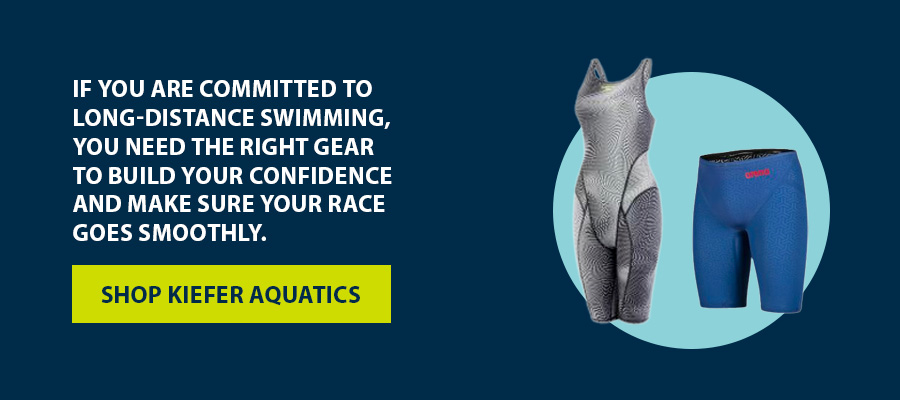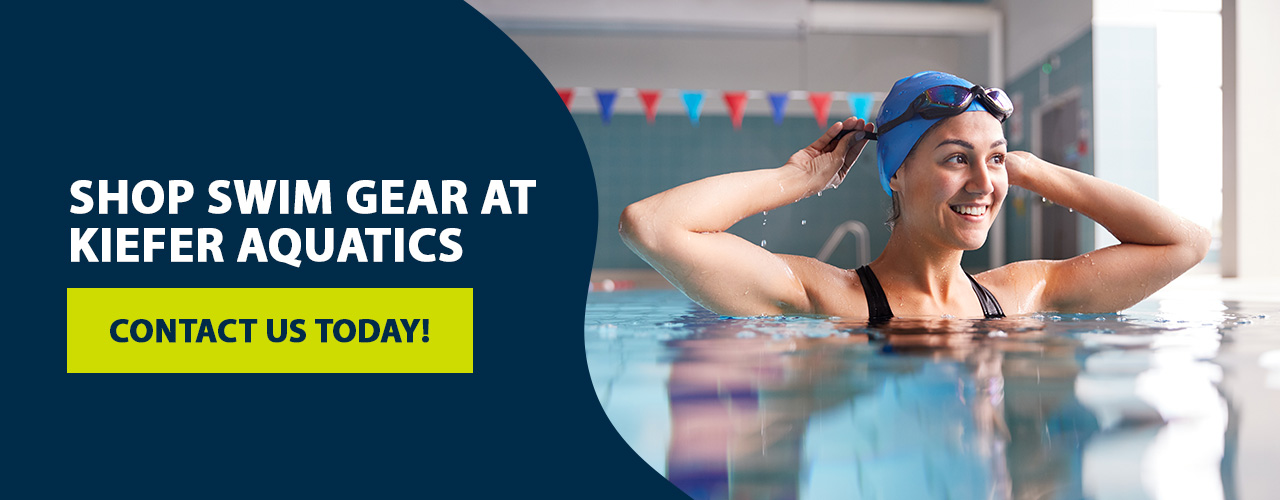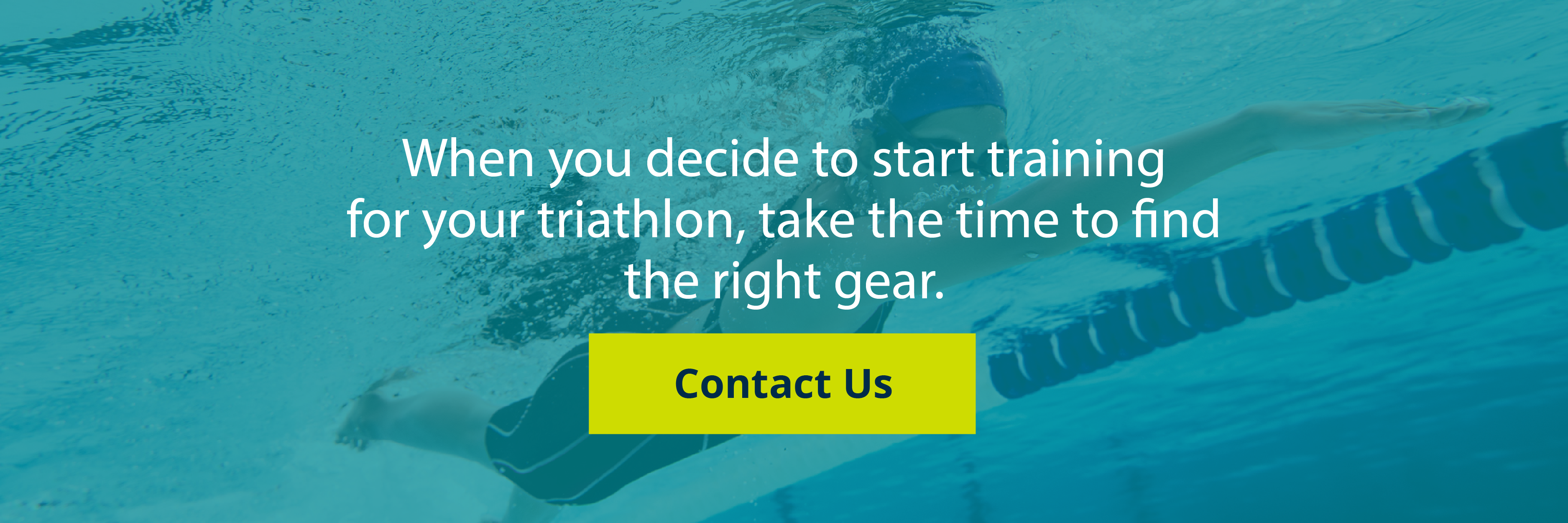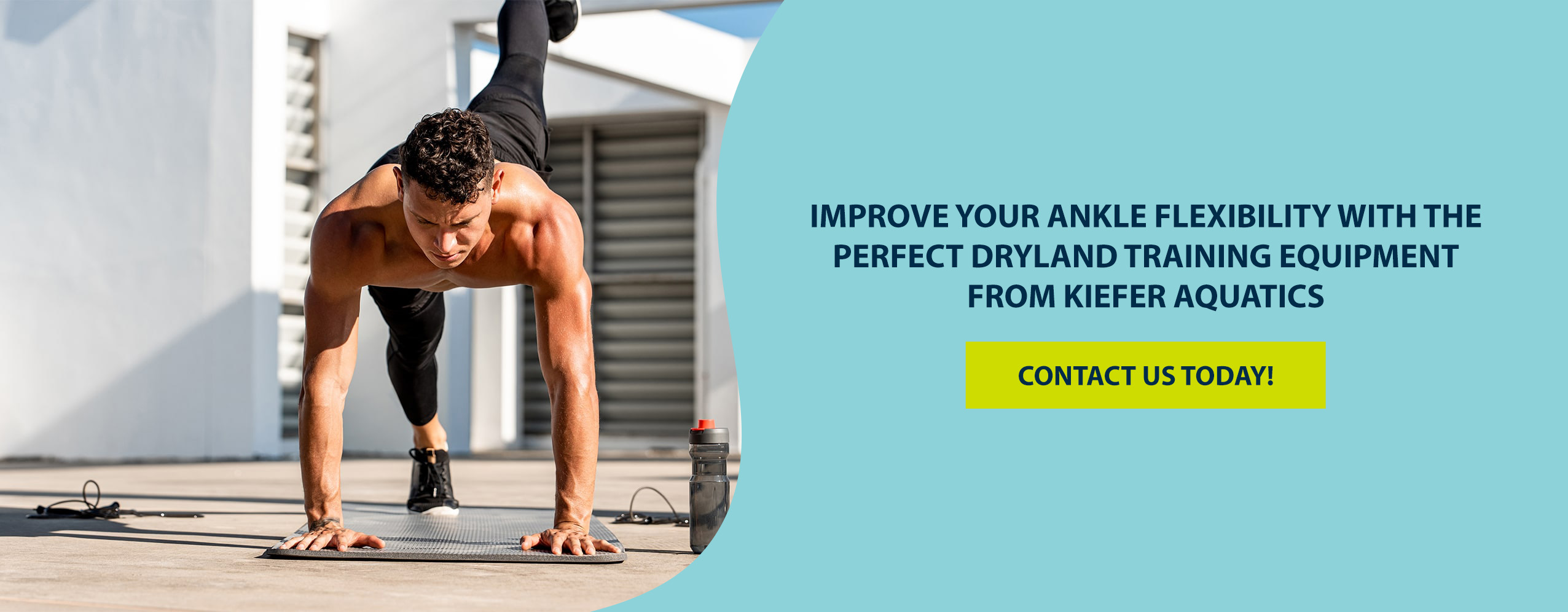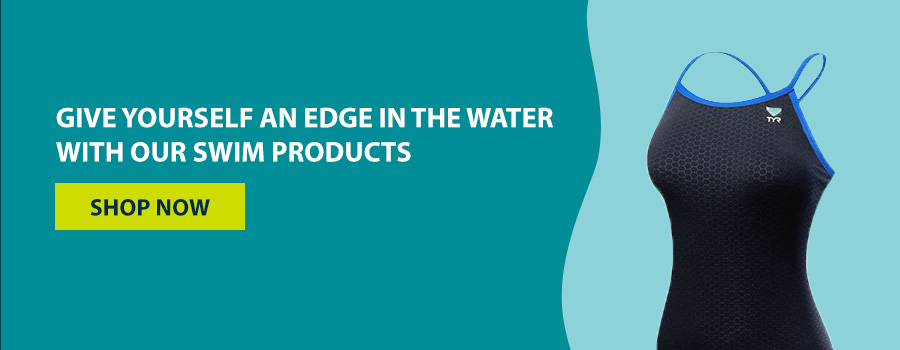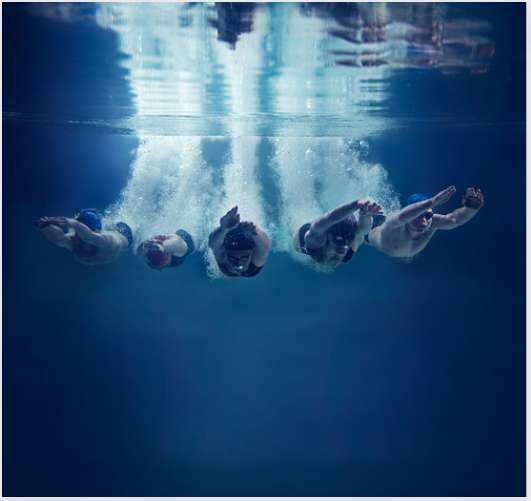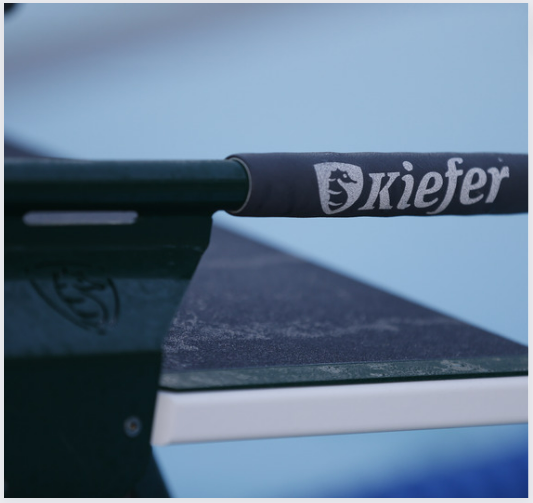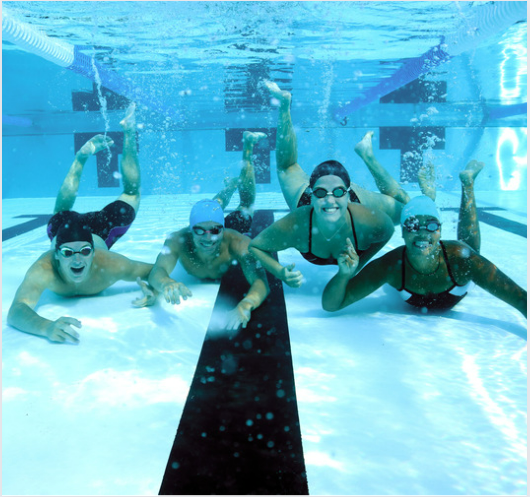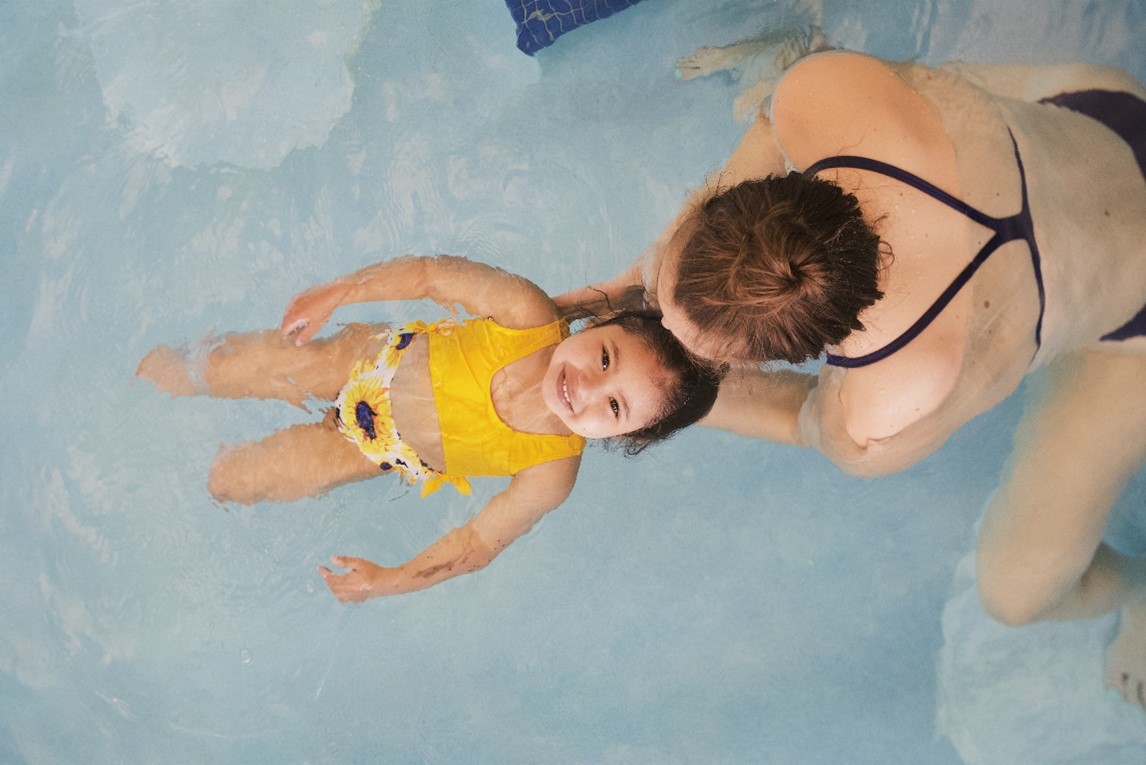Swimming News
Tips for Swimming Long Distance
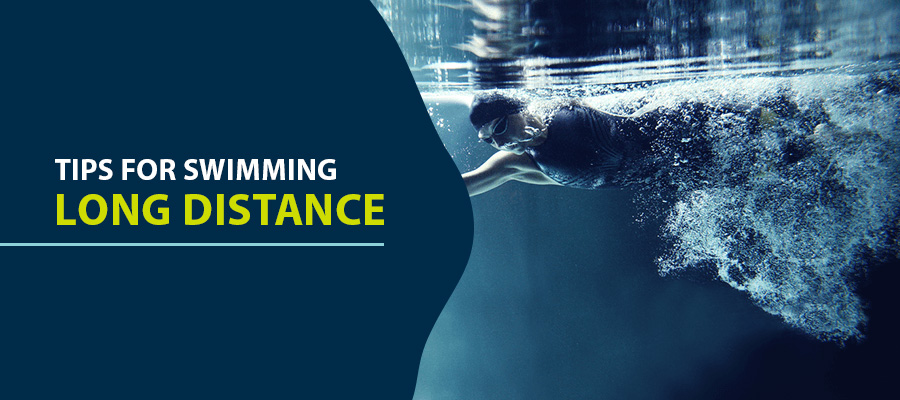
Tips for Swimming Long Distance
Long-distance swimming is an intense and rewarding challenge. Some swimmers like to go the distance purely for exercise, while others are in it for a race. Whether you are looking to add miles to your workout or you are gearing up for the swimming portion of a triathlon, distance swimming takes preparation. As with any form of intense exercise, your muscles need time for training. You don't want to find yourself exhausted in the middle of a workout or a race. Learn how to swim long distances with tips on techniques for in and out of the water.
How to Swim Long Distance
- Hone your breathing technique: Practiced long-distance swimmers have their breathing patterns down to a science. Quick, uneven gasps of air will make you tire faster and slow you down. On the other hand, even, well-paced breathing will keep you on course. Keep these tips in mind while you work on your breathing.
- Exhale fully: Our instinct is to conserve as much air as possible when we exert ourselves. This instinct can lead to shallow breathing, which causes the body to tire sooner. When you place your face in the water as you swim, be sure to exhale completely. You should see a long stream of bubbles trailing from your nose. If you do not exhale completely, carbon dioxide begins to build up in your body. It will quickly make you feel like you are out of breath. Take your time when you breathe. Take full inhales and long, complete exhales.
- Create a rhythm: Tying breath to movement creates a rhythm that can help you effectively use your energy. Many athletes will create a mantra for themselves as they breathe and move. This chant could be a simple count of "one" for inhale and "two" for exhale.
- Alternate sides: Many swimmers choose a particular side for breathing, but long-distance swimmers may find an alternating patter to be helpful. Switching sides can keep you aware of your surroundings, which is particularly helpful for open water races. Alternating sides can also help swimmers stay on course. One-sided breathing often requires constant course correction to avoid zig-zagging in the water.
- Practice your stroke: How will you complete your distance swim? Will you swim freestyle the entire way? Or, will you change up your stroke? No matter what approach you decide to take, you will need to practice the stroke to ensure it is smooth and even in the water. Long-distance swimming may be a race, but the way to win is with smooth, effective strokes, not the fastest stroke.
Each stroke matters. Move with intention. Strong swimmers keep their bodies streamlined. During freestyle, your body will rotate as your legs make small, measured kicks and your arms arc up and down smoothly. Keep your head steady as your arms and legs do the work to propel you forward. Efficient strokes will help you conserve your energy and move toward your goal faster.
- Give yourself time to build endurance: If you want to know how to swim long distances without getting tired, endurance is the most significant factor. Even if you are a seasoned bicyclist and runner, it will still take time to build up your long-distance swimming stamina. Do not expect to hop right into the water and immediately complete the aquatic leg of a triathlon with no preparation. Spend time training in the pool. Pay attention to your stroke and breathing. Build on the distance you incorporate into your workout. Try interval training, which includes warm-ups, sprints and cool-downs. If you have the option, try some of your training in the open water, so you can become familiar with that environment. It is a different experience than swimming in a pool.
You can work on your endurance outside the pool as well. Weight training and exercises like yoga can help improve core strength, which is essential to maintaining a strong, smooth stroke as you swim.
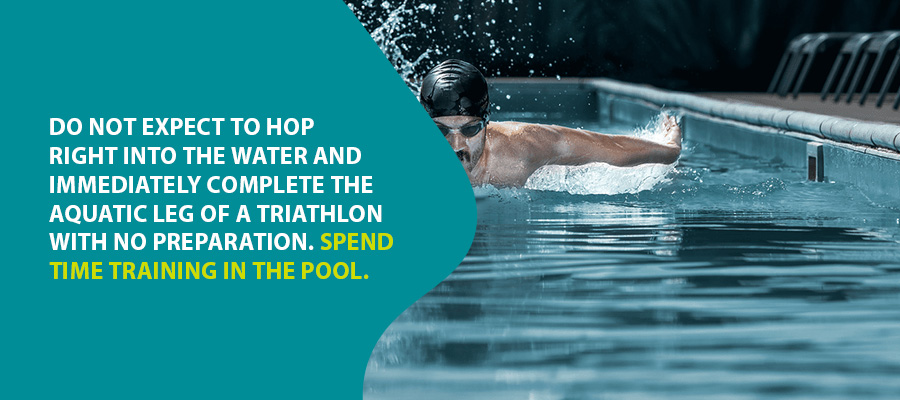
- Keep your diet in mind: Not all distance swimming tips are about what you should and should not do in the water. All endurance athletes know the importance of the food you eat during training and the times leading up to a race. Preparing for a long-distance swim can be grueling, even more so if you are simultaneously training for the rest of a triathlon. Remember to eat food with plenty of carbs and protein to fuel your workouts. Whole grains, lean proteins and fresh fruits and vegetables are staples of the long-distance swimmer's diet.
On race day, you might feel too nervous to eat, but it is essential to give your body the energy it needs to move you through the water. Some swimmers eschew solids in favor of protein shakes. Others prefer the solidity of bananas or energy bars.
- Learn how to sight: Long-distance swimmers typically get in their workouts and races in open water instead of the pool. If you are racing, the course will have buoys or flags at regular intervals. If you are unfamiliar with swimming in open water conditions, you will need to prepare yourself to spot these markers, which will keep you on course. If you are swimming long-distance recreationally, you will need to ensure the area you have chosen has enough markers to keep you from drifting too far off shore and becoming disoriented.
- Work with the water: If you are swimming in open water with frequent waves, do not try to fight the waves to catch a glimpse of a course marker. Instead, wait for a swell to carry your body forward. At the top of the wave, try to sight the marker. If you are swimming in smooth conditions, try to sight as you turn your head to breathe.
- Adjust your stroke: Time is precious, especially during a race. You do not want to stop swimming and tread water to sight a marker. If you are looking, temporarily kick harder to keep your body moving forward as you move your head to catch sight of a marker.
Get the Right Gear
If you are committed to long-distance swimming, you need the right gear to build your confidence and make sure your race goes smoothly. The suit is a critical piece of equipment for any swimmer. You can find the right style and color of swimwear to suit your style. Serious racers may want to invest in a tech suit to help improve your performance. You will also need a good pair of goggles to keep your vision clear as you move through the water stroke by stroke. Browse All American Swim's wide selection of swimwear and swimming gear to prepare for your plunge into long-distance swimming.
Pacing Tips for Your Swim Meet
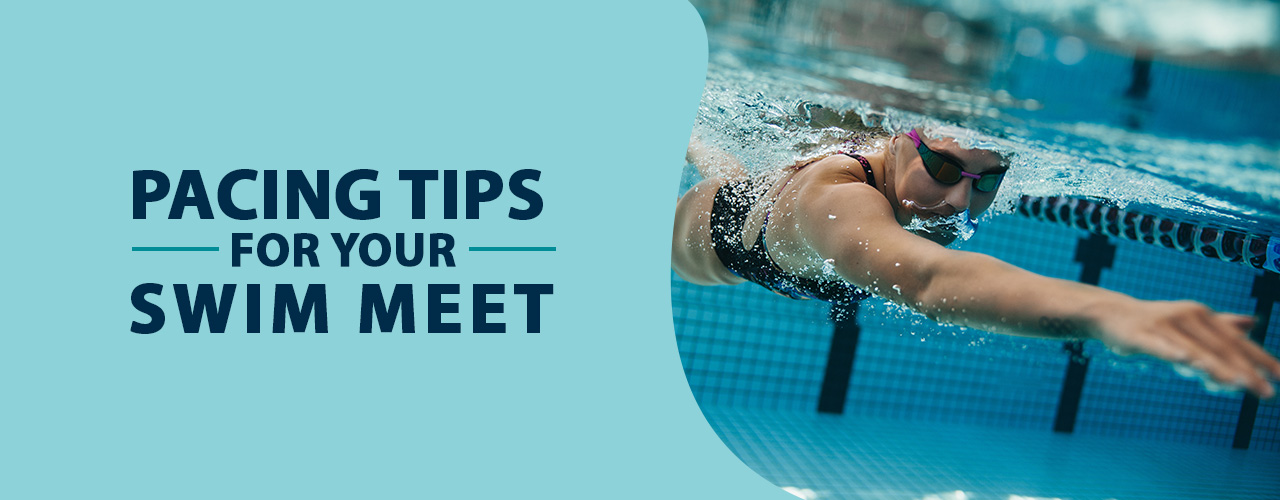
Pacing Tips for Your Swim Meet
Whether you're a casual swimmer or training for a competitive meet, maintaining a sustainable swimming pace is a critical part of your success as you improve. Your pace is what will help you meet your goals, preserve your strength and become a more powerful, controlled athlete.
Learn more below about the importance of a good swimming pace and tips for achieving it.
Why Swim Pace Is Important
Swim pace is the best way to practice control over yourself while training and competing. It helps you avoid premature burnout and preserve the perfect amount of energy to help you cross the finish line or meet your lap time goals. For most competitive athletes — especially those engaged in long-distance swimming or triathlons — this precision is critical for success.
Understanding and controlling your pace is also an effective way of reducing injury or excessive strain. When you're constantly pushing yourself to go as hard or fast as you can, it's easier to tear or strain a muscle. You may not immediately feel the warning signs in the water, either. By the time you realize it, you could've pushed your body too far, causing an injury that takes weeks or months to heal.
All of this control also helps train your mind and body to be a more disciplined athlete. The more in-tune you are with yourself, the better you can set and achieve new milestones.
Of course, pace isn't always necessary. Casual swimmers who hit the water for fun or stress relief don't have to worry too much about watching their speed. Most fitness swimmers, athletes, team members and professionals should find their pace except in certain circumstances. Engaging in activities like ultra-short race-pace training (USRPT), which focuses on exerting all available force and intensity for a short interval, doesn't require managing speed.
What Is a Good Pace for Swimming?
No matter what type of swimmer you are, your ideal swim pace is one you can sustain for extended periods. Sustainability and longevity are key — not speed. Once you've secured your momentum and practiced with it, you should be able to maintain it regardless of speed, distance or other factors.
Your swim pace also depends on things like:
- Type of swimming: Though having a base pace is an essential starting point, you may need to adjust your goals depending on the type of swimming you're doing. Racing usually requires a different pace because you start with a dive, which crosses distances faster than starting with basic laps and no dive. The pool's length also matters — when you kick off walls more frequently in a smaller pool, you're going to move faster through the water.
- Personal and professional goals: For personal goals, you might set a pace that feels comfortable and push yourself to get better as your skills improve. Non-competitive fitness swimmers may aim for a baseline pace to reach a good heart rate zone. Professional and competitive swimmers will have a far different pace, adhering to industry standards, team goals and competition requirements.
- Fitness level: Never establish a pace you cannot safely sustain. Account for your current fitness and activity level and take it slow. Allot plenty of time to warm up and cool down.
For an estimated starting point for reference, many swim facilities or coaches have pace charts to give you a good idea of other swimmers' rates in your category. To identify and control your pace, see how fast you can swim a 100-meter or 100-yard lap at a comfortable, sustainable speed. Multiply this number to apply it to longer intervals. Once you've found your estimated ideal pace, you can adapt it to other types of swim environments and competitions.
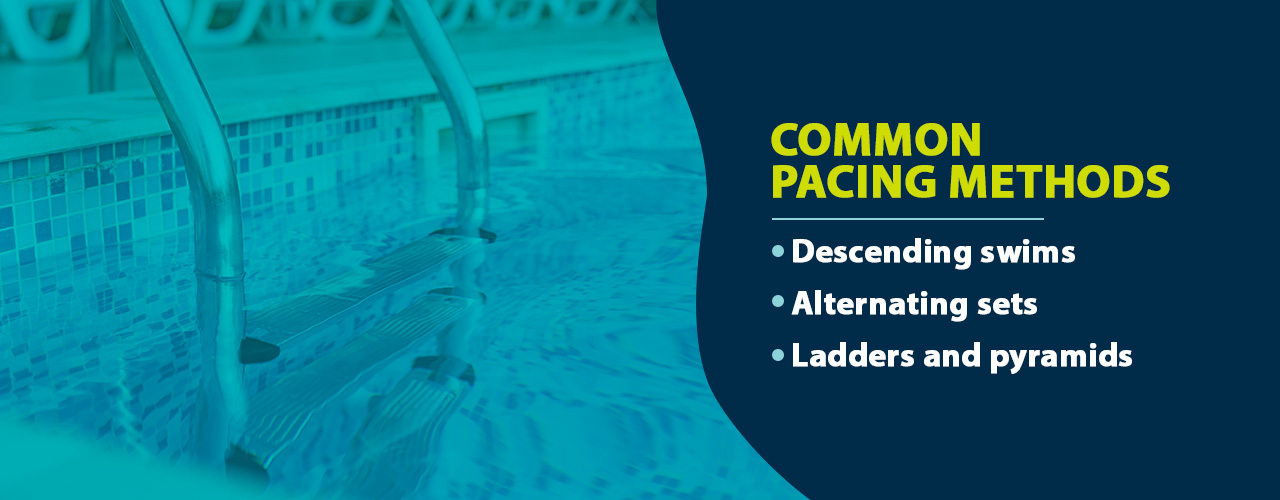
Common Pacing Methods
Before finding and training with your pace, predict what your lap and set time will be. Then use a pace clock or pool timer to see how accurate you were. You can bridge the gap between your perceived and actual pace to establish a more sustainable, realistic baseline to build on.
After confirming your base pace, incorporate a balance of speed and endurance drills into your training. Speed lets you play with your average pace and improve over time, while endurance sets enable you to practice setting and maintaining that same momentum regardless of distance.
A few common pacing methods and practices include:
- Descending swims: Descending swims focus on maintaining a consistent pace instead of slowing or increasing your speed. You start with a longer interval — like a 60-second lap — then gradually decrease the time by a few seconds each set while keeping your pace the same.
- Alternating sets: Alternating your sets between mild, moderate and intense swim intervals helps you train your body to start and stop without changing your pace.
- Ladders and pyramids: Ladder swim training is when you maintain a consistent pace while repeating and increasing your distance each time, keeping that same base momentum as you go. Pyramid training is when you repeat and reverse the ladder process by reducing your distance and maintaining the same pace.
How to Pace Your Swim
Here are some helpful tips for pacing during a swim:
- Know what type of swimmer you are: Different types of swimming have different requirements. Sprinters go shorter distances at higher intensities, while long-distance swimming requires a steadier, more consistent momentum. You also need to know your body and what your average pace is for each swimming scenario to build muscle memory and set realistic expectations.
- Work with a coach or trainer: Work with a coach or swim trainer who can keep you accountable and offer an outside, non-biased measurement of your pace and achievements. You can learn the difference between your perceived exertion and your actual realistic pace.
- Mind your turns: One of the most challenging lap and race-pace swimming tips is minding your turns. If you're just starting competitive swimming or have yet to determine your pace, taking turns at the wrong time could interrupt your maintained speed.
- Be prepared: Maintaining a good momentum starts before you ever get in the water. Managed breathing is a critical part of keeping pace — incorporate plenty of breathing exercises into your training routine. Fuel up with nutritious meals and practice active recovery while you're in the water. Remember to be gentle with yourself and your expectations. When it comes to pace, sustainability is always more important than speed.
Shop Swim Gear at Kiefer
Learning how to find and maintain an adequate, sustainable pace is challenging, but it's a valuable technique for meeting your swimming goals. Investing in the right swim gear can help you find your pace and stay safe and comfortable while you train.
Kiefer has all the swimming equipment you need for professional, competitive and casual swimming, with quality options from the industry's top brands. Shop our swim gear today to find just what you need.
How to Train to Swim in a Triathlon
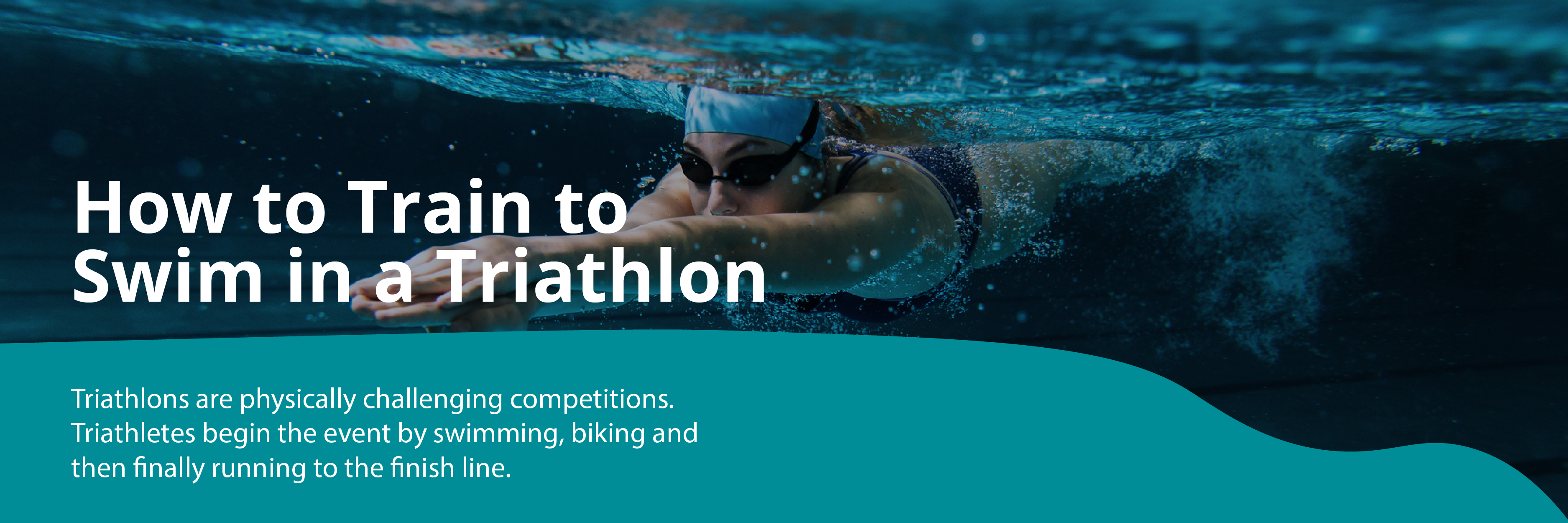
How to Train to Swim in a Triathlon
Triathlons are physically challenging competitions. Triathletes begin the event by swimming, biking and then finally running to the finish line. Depending on which triathlon guidelines the event adheres to, the distance for each portion of the challenge will differ. For example, the Olympic guidelines for a triathlon include 0.93 miles of swimming, 24.8 miles of bicycling and 6.2 miles of running. An Ironman Triathlon ups the challenge with 2.4 miles of swimming, 112 miles of bicycling and 26.2 miles of running. Other variations on the triathlon will require different distances or even mix up their order of events. Regardless of which guidelines your event follows, you will need to get into the water and swim.
When you commit to triathlon, you need to get your endurance level and conditioning up. Use these triathlon swimming tips to prepare for the first leg of your competition.
Tips for Preparing to Swim in a Triathlon
- Swim Training: If you are looking for a guide on how to swim a triathlon for beginners, the first step is simple. Find a pool where you can get in the water and train. Set aside time each week for swimming laps and timing yourself. You can train solo, or you can seek out other triathletes gearing up for the race. No matter how you prefer to practice, commit to a regular schedule and track your progress. Triathlon swim training is just as essential as preparing for the biking and running portions of the race.
- Training Tracking. A triathlon training schedule is a rigorous process that requires a lot of planning. When will you get in the pool? How many times a week? How will you track your progress? Instead of trying to rely on your memory, invest in a swim log and goal planner to keep you on track. You can easily keep track of your workouts and training milestones as you work toward the day of the race. Swim logs can even offer helpful insight into training technique.
- Proper Training Equipment. On the day of the race, you won't need much equipment for the swimming portion. But, you can use different gear to help you as you train. For example, kickboards and fins can help you strengthen your legs and hone your kick technique. Likewise, paddles can help you strengthen your arms and improve your stroke. If you want to focus on your arm and leg movement without thinking about breathing technique, you can use a training snorkel.
- Proper Racing Gear: When you are training for your triathlon and then finally competing, you need the right equipment. Serious triathletes typically invest in separate swimsuits for training and race day. The chlorine of a pool can damage your suit, and you want your race day suit in top condition to help you perform at your best. Opt for the same suit or a similar style for training and racing, so you get accustomed to the feel and performance of the suit before the actual competition.
When it comes to selecting a swimsuit, you have plenty of options designed specifically for racing. For example, many triathletes opt for tech suits. Tech suits fit on your body like a second skin, which offers the benefit of compression. You will be able to move through the water faster. Tech suits also have longer legs — usually extending down to the knee — which can make the transition to biking and running more seamless. Depending on the temperature, you may need to wear a wetsuit over your triathlon biking and running gear. After the swim, you remove the wetsuit and race on to the next leg of the competition.
The swimsuit is the most impactful decision to make when it comes to swimming gear, but you will also need a swim cap and goggles with anti-fog lenses. If you know you will be competing in sunny conditions, it can also be helpful to buy a pair of goggles with tinted lenses. Many triathletes keep two pairs on hand in case the strap of one breaks. Some triathlons provide competitors with swim caps on race day, so you should get used to practicing with one. Bring one with you on race day just in case. Try on the one available at the event to see if it is a comfortable fit. If not, you will have a backup swim cap in your gear.
- Mental preparation: A triathlon, especially for first-time competitors, can be an intimidating and grueling experience. You want to perform well, and the pressure is high. Factor mental preparation into your training routine. Set goals for your swim time, but don't let the desire to meet those goals sap all the enjoyment from the event. Completing a triathlon is a significant achievement worth celebrating.
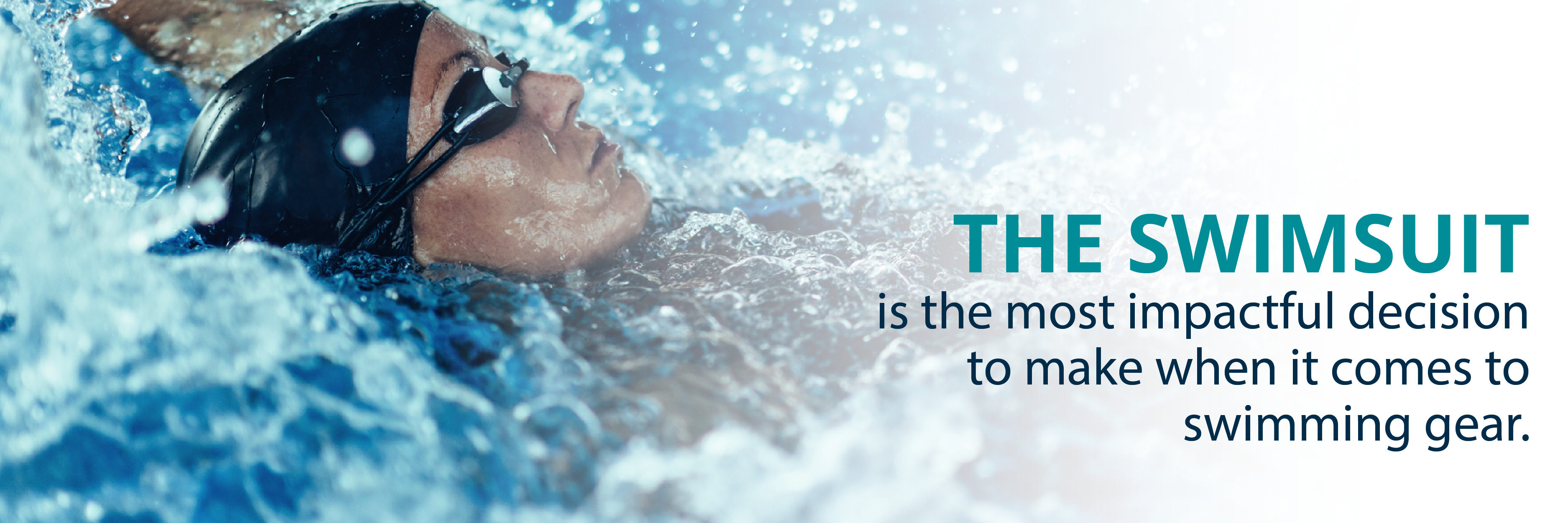
How to Improve Your Triathlon Swimming Technique
If you signed up for a triathlon, you likely already know the basics of swimming. You will need to spend your training time improving your technique to shave valuable seconds off of your time. Here are triathlon swimming tips for beginners.
- Kick: Your legs provide a great deal of propulsion when you are in the water. Some triathletes focus on saving their leg strength for biking and running, but maximizing your efficiency in the water requires a strong kick technique. Good kick technique is not about how fast or furiously you move your legs. Instead, it is about mindful, balanced kicks that help keep your body balanced in the water. Practice your kick by taking your arms out of the equation. Use a kickboard and do laps using only your legs. Ankle strength is an underrated, but central, component of an efficient kick technique. Work on ankle strength outside the pool by doing ankle rotations and exercises like skipping rope. These dryland exercises can do double duty as training for the running portion of the triathlon.
- Pull: A triathlon swim also requires upper body strength. When swimming freestyle, your arms will do approximately 90% of the work to move you through the water. When working on your technique, break down the arm movement into its separate parts: down-sweep, in-sweep, upsweep and recovery. Your arms move in alternating motions. While one is coming up out of the water, the other is extending underwater along your body. The arm that moves upward will have a bent elbow, while the arm in the water will pull straight back. The arm beneath the water will have a moment to recover before it sweeps upward and out of the water. The position of your hands is also an essential part of pulling yourself through the water. Keep your fingers tightly together, forming one smooth line from your wrist to your fingertips. Each hand will enter the water at an angle to minimize splashing and unnecessary drag. As you practice, work to make your arm motion one smooth cycle.
- Head position: While your arms and legs do the work of moving you through the water, the way you position your head is an essential part of your technique. You will place your face in the water, keeping your head in line with your body. As your arm moves up to stroke forward, you will turn your head to the side just enough to take a breath. When your arm comes down, you will turn your head to place your face back in the water. If you want to practice just your head position and breathing, you can use a kickboard. With your arms straight in front of you, try moving through the water using only your legs. As you move, you can practice the back-and-forth movement of your head. You can also make this drill completely static by placing your arms straight on the edge of the pool.
- Watch yourself: Triathlon swimming technique can be hard to master when you can't track your progress. If you have a training partner, take turns filming one another. Watch video of yourself to determine which areas of technique you still need to hone. Watch how you kick, how your arms enter the water and how you position your head. Having this visual training tool can help you measure your progress and adjust your training regimen as needed.
A Swim Training Plan
You will likely swim freestyle during the race. Naturally, this stroke will be a big part of your swim training plan, but it won't be the only stroke you swim. Triathlon beginner swimming incorporates other strokes like breaststroke. Each person will have a unique training swim training plan, but you can build those plans with basic exercises, such as the following.
- Warmups: As with any type of exercise, you want to warm up your muscles first. Swimming warmups involve shorter distances and reps. For example, you can warm up with six 50-meter laps with a focus on kick drills. You can also keep things simple by warming up with a brisk 400-meter swim.
- Main workouts: Swimming in a triathlon is all about endurance, which means your training should help you build that necessary stamina. Swim a medley of 100 meters each of freestyle, breaststroke, backstroke and butterfly to build up endurance. You can also work in technique training into different sets. For example, swim 400 meters of freestyle while working on your breathing technique. You can also time yourself swimming the entire distance your triathlon requires, whether Olympic or Ironman guidelines.
- Cooldowns: After pushing yourself through your swimming workout, you will want to give your body a chance to cool down. Try a 200-meter swim at a slower pace. You can also do four 50-meter laps with rests between each lap. Do 25 meters of freestyle and 25 meters of any other stroke.
Remember, you will want to start your training at least six weeks before the date of your triathlon. You will need that time, or more, to build your stamina and hone your swimming technique. Balance your swim training with your biking and running training.
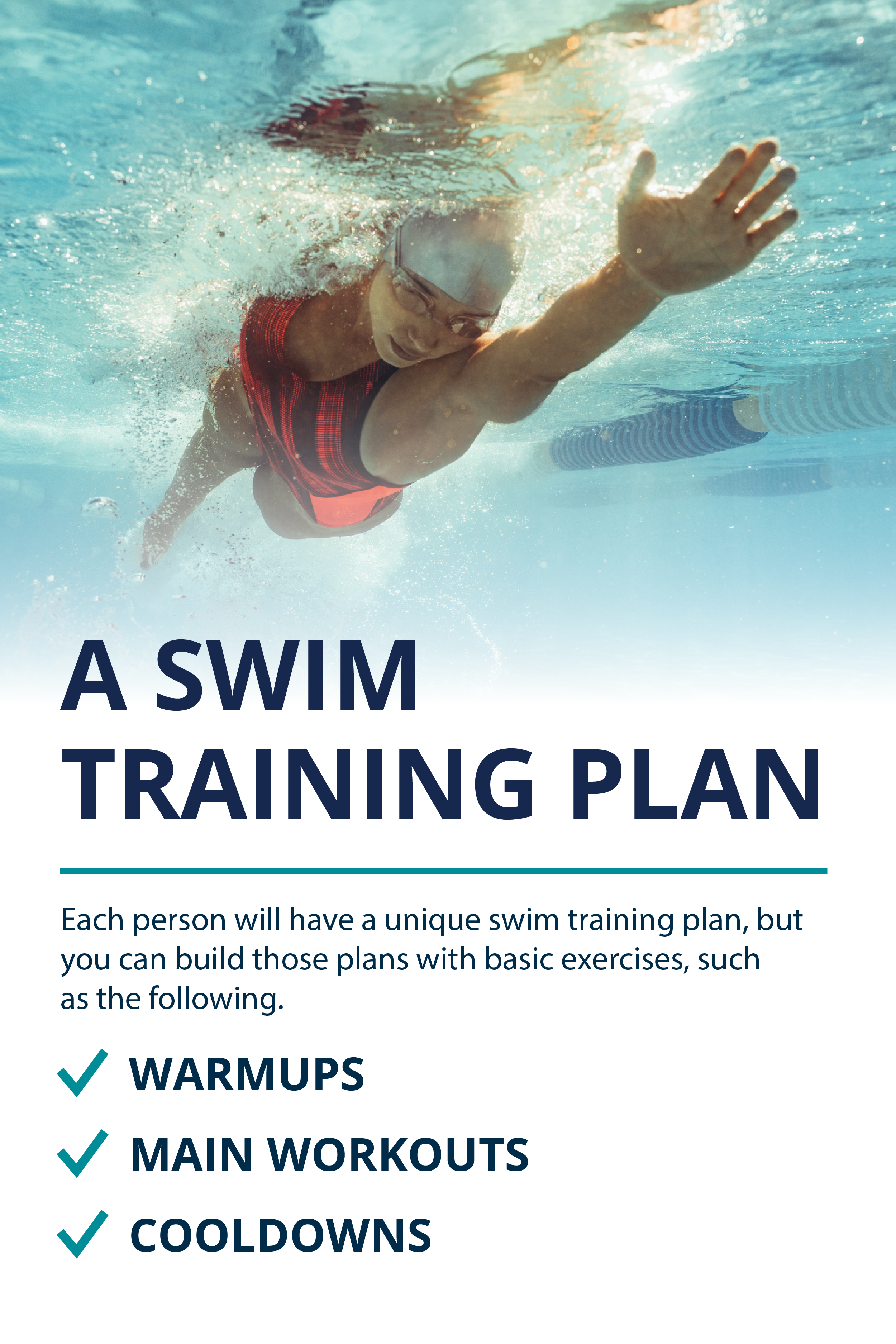
What to Do the Week Before the Race?
Training for a triathlon is intense. After your workouts, you might feel sore and depleted of energy, which is why it is vital to taper your training as race day approaches. You want to keep your body in top shape for the race, but you do not want to push yourself so much that you will struggle to perform at your best during the actual event. The week before the event, your training will be lighter. Swim training will only take up two days of your pre-race week, leaving room for you to slow down your biking and running workouts as well.
- First day of swimming: On your first day of swim training, you will spend a short amount of time in the pool with a quick warmup, a few sets and a cooldown. Swim between 300 and 400 meters to warm up in the water, which works out to eight laps in a 50-meter Olympic-sized pool and 16 laps in a standard 25-meter pool. After you have warmed up, you can time yourself on 50-meter sprints. Complete up to eight sprints and allow yourself time to recover between each set. This light workout is designed to get you ready for the big day, but it won't fatigue your muscles and affect your performance on race day.
- Second day of swimming: You may want to give yourself a day or two between swimming workouts the week before the race. When you do get back into the water, this workout will be even more low-key than the first one. Swim 800 meters at a leisurely pace. Focus on your form, but do not push yourself too hard.
What to Do on Race Day?
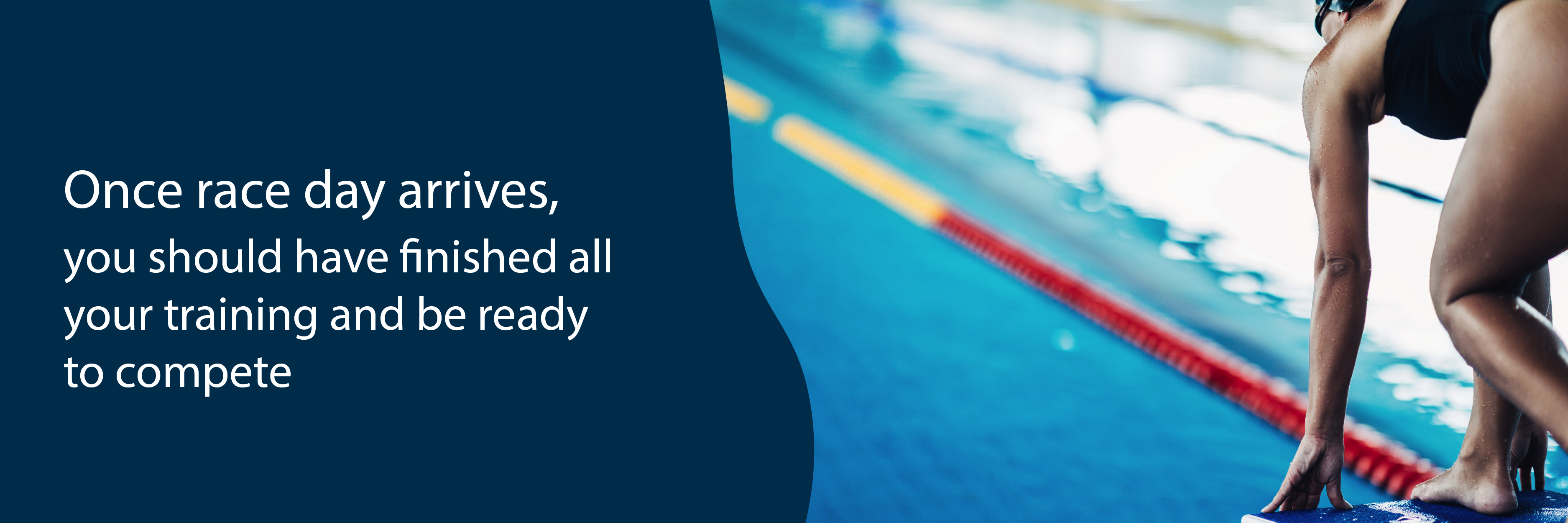
Once race day arrives, you should have finished all your training and be ready to compete. You don't want to cram in any last-minute practice. It is better to save your energy for the actual triathlon. But, there are a few things you can do to make sure you are ready to race at your best.
- Eat: You may be a bundle of nerves before you even get to the start line, but you should still get some food in your stomach. Make yourself something substantive about two hours before the race begins. That gives you some time to digest your food while still giving your body the fuel it needs. Choose foods that are part of your regular diet. Race day is not the time to try out something new. Go with something high in carbohydrates, such as pasta or pancakes. If you can't stomach the idea of solid food, blend yourself a high-protein smoothie with ingredients like fruits, veggies and oats.
- Organize your gear: Take the time to organize your equipment before you leave for the race. Do you have your swimsuit, goggles and a spare swim cap? Do you have any extra items like a nose plug and earplugs? Do you have all the gear you will need once you hop on the bike and hit the ground running? Being organized not only ensures you have everything you need, but it can also help soothe your nerves.
- Prepare transition areas: Arrive early enough to give yourself time to check in, test out any gear the race organizers provide you and, perhaps most importantly, set up your transition points. During the race, you want the shift from swimming to biking and then biking to running to go as smoothly as possible as you push yourself toward a personal best time. Set up your gear at each transition point and mark it with something that will make it easy to recognize. You do not want to waste valuable time searching for your bike and running gear.
- Find your starting place: When it is time to line up for the start of the race, find yourself the best possible position. If you are a triathlon beginner, consider starting further back from the crowd. Triathlon etiquette dictates the fastest swimmers should enter the water first. If you are confident in your swimming abilities and expect to be at the head of the pack, position yourself accordingly. No matter where you are in the starting line, remember to give your fellow competitors ample space.
- Celebrate success: Regardless of your finishing time, you should celebrate your success. Finishing a triathlon is an impressive achievement. If you are looking to improve your time, you can always adjust your training schedule and sign up for another competition.
Kiefer — Your Home for Triathlon Equipment
When you decide to start training for your triathlon, take the time to find the right gear. Browse Kiefer for the swimwear and gear you need to train for and compete in the swimming portion of a triathlon.
How to Improve Your Swimming Speed
How to Improve Your Swimming Speed
In 2010, Michael Phelps reached a swimming speed of about six miles per hour. The record for swimming a men's 50-meter short course (50 meters in a 25-meter pool) is 20.91 seconds. Not every swimmer is going to achieve Olympic Gold and record-shattering speeds, but it does spark inspiration to move faster through the water during your swim workouts.
The four basic swimming strokes are freestyle, breaststroke, backstroke and butterfly. While you move your body differently for each stroke, the main determinants of speed are thrust and drag. The water provides resistance (or drag) while your arms and legs propel (or thrust) you through the water. Learning how to effectively move your body through the water for each different stroke will help improve your time.
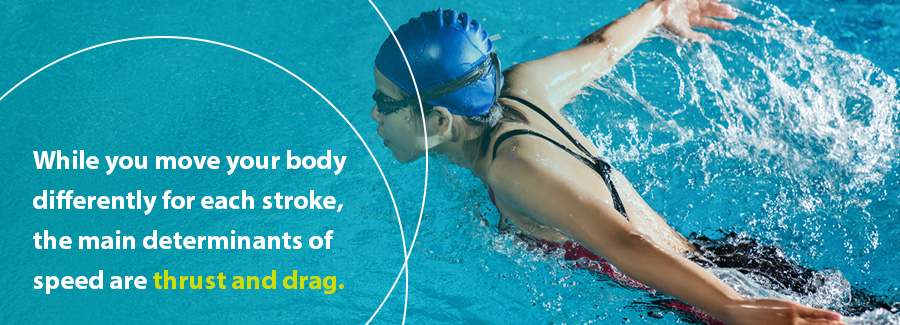
Once you have the basic arm and leg movements down for the stroke you're trying to speed up, you can focus on the nitty-gritty elements of your swim time. You can shave valuable fractions of a second off of your time by improving each of these elements:
- Underwater time: This number is the total time you spend under the water.
- Turn time: Turn time is the amount of time it takes you to turn and begin your next lap.
- Cycles: In swimming, one cycle is the equivalence of a single stroke. So, your cycle count is the number of strokes it takes to finish your timed swim.
- Stroke rate: This rate is the average speed of your strokes. To determine stroke rate, you should divide the number of strokes taken during your timed swim by the total time.
- Reaction time: If you're taking off from the blocks, this term refers to how long it takes you to get from the block to the water.
You'll need some dedicated coaching to get accurate times for each of these elements. Whether you have a coach or not, there are plenty of ways to achieve a faster swimming speed. Here, we'll talk about how to swim faster by improving your technique, exercising outside of the pool, committing to improvement and buying the right swim gear.
Focus on Your Arm Movement
Your arms do a lot of the work it takes to move you quickly and efficiently through the water. You can calculate your own stroke count by noting each time your arm enters the water during freestyle, backstroke, breaststroke or butterfly. Remember, when swimming backstroke and freestyle, your arm movements are not synchronized. That means you have the choice of counting in half cycles of full cycles.
For a half cycle, you'll count when either arm enters the water. For a full cycle, you will only count when your left or right arm enters the water. To become faster, swimmers can either reduce the number of strokes it takes to cover a certain distance or make their strokes faster. During your next workout, count your strokes. The number you get can be a great baseline to see how different arm techniques change your stroke count and overall time.
Freestyle
When you swim freestyle, your arms account for 90 percent of your thrust through the water while your legs do what little work is left. That means knowing the proper arm technique and refining it will help you improve your speed.
In freestyle, your arms move in an alternating fashion. One arm is beneath the water, stretched forward as far as possible, while the other is out of the water, arching above your body.
The arm that is above the water is bent, with your hand and fingers completely straight. Your hand will enter the water first, while your elbow comes last. Pull forward and allow your arm to go all the way back to your waist before you begin your next stroke. As you alternate arms, your body will slightly rotate in the direction of the arm above you.
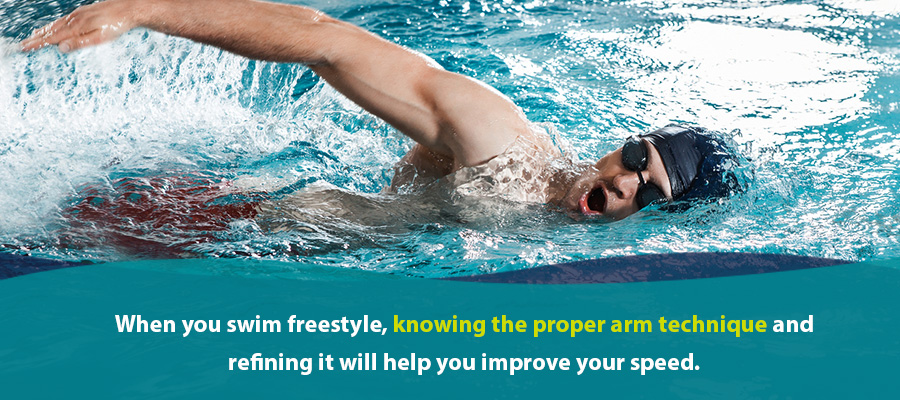
Backstroke
When swimming backstroke, you also use an alternating arm movement, but your arms will remain straight when out of the water. As one arm comes up, keep it fully extended, and rotate your palm to face outward as you move your upper arm — then the rest of the arm — into the water. The arm then completes a down sweep.
You will then pull your bent arm backward to help push you through the water. The upsweep movement occurs when the arm and palm rotate to face inward. You will then move your arm up out of the water.
Breaststroke
When you're swimming breaststroke, proper arm movement begins with both arms stretched out in front you, palms facing outwards. You will move both of your arms outward. Then, bend your arms so that your palms are lined up with your forearms. Next, your arms will begin to move backward, and then bring your arms up toward your chest with your palms facing one another. Once you have completed this movement, you will extend your arms in front of you, and the stroke begins again.
Butterfly
The arm movement for butterfly is similar to that used in freestyle, except your arms both move at the same time instead of alternating.
It can be easy to mimic the arm movements by watching other swimmers, but the finer details might get lost. Focus on honing your movements. This focus on precision can help you to become a faster swimmer.
Refine Your Kick
How you move your legs in the water is just as important as how you move your arms. Here is how to improve speed in swimming by enhancing your kick technique.
- Freestyle and backstroke: Both freestyle and backstroke use the flutter kick to move you through the water. It might seem counterintuitive, but bigger kicks do not necessarily mean better. The flutter kick involves quickly moving your legs up and down in an alternating fashion. When you kick, try to keep your knees as straight as possible. If you bend them too much, your legs will do very little to move you through the water. While you kick, concentrate on making smaller movements. You don't need to make big splashes with your feet.
- Breaststroke: The synchronous leg movement used for breaststroke is often called the "frog kick" because your legs move much like the amphibians'. First, your legs bend at the knee and the hip, coming up beneath your torso. Next, you turn your toes and knees out as you move your legs apart. Your legs will move downward and outward in a circular motion. As they come close to completing the circle, move your toes and heels back into a straight line. Repeat the circular motion.
- Butterfly: The leg movement used when swimming butterfly is known as the "dolphin kick." This kick is simple to learn, but it can be difficult to master. During dolphin kick, your legs will stay straight and together with your feet pointed. Your legs will kick much like a dolphin's tail does, through a rhythmic up and down motion.
Perfect Your Breathing Technique
When you want to improve your speed, every breath counts. Finding the correct position for your head is the first step to improving your breathing technique. When you're swimming any kind of stroke, you want your head to be aligned with the rest of your body, creating one smooth plane that moves easily through the water.
You keep your head in line with your body by looking down toward the bottom of the pool as you swim (or up at the ceiling during backstroke) rather than looking forward. Looking forward will cause your body to go deeper into the water and make more work for you as you swim.
Backstroke makes breathing easier because your face remains above the surface of the water the entire time, but to accomplish efficient freestyle, breaststroke and butterfly, you need to put your face in the water with each stroke. Here are two tips for perfecting your breathing technique for these strokes:
- Exhale when you're in the water: When you see underwater videos of professional swimmers, you see a constant stream of bubbles coming from their nose. That's because they're exhaling every time they put their face in the water. It might seem like common sense to exhale when you turn your head to breathe (like in freestyle) or when your head pops above the surface (like in breaststroke and butterfly), but you'd have only a short window to exhale and inhale before your face enters the water again. Shallow breathing means growing tired and slowing down much faster.
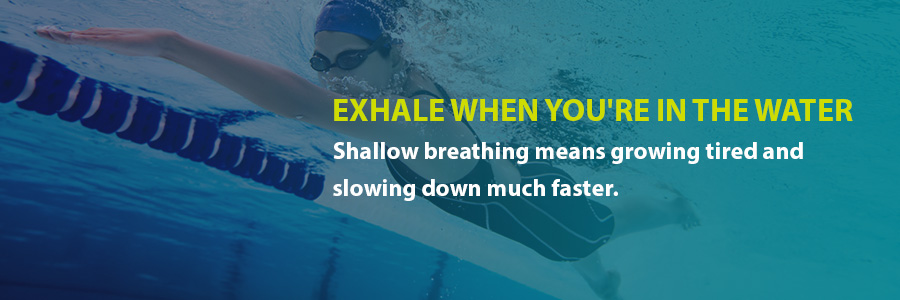
- Find your rhythm: Once you're comfortable exhaling while underwater, you can focus on finding the right breathing rhythm. Concentrate on making each breath and exhale the same length. During freestyle, do your workouts with bilateral breathing. This term means turning your head to both sides of your body to take a breath. This strategy will ensure that you're working the muscles on both sides of your body evenly. When it comes to race time, you can use bilateral or unilateral breathing.
Once you have your breathing down, you can concentrate on the movement of your body and what you can do to up your speed.
Work on Flexibility and Strength Outside of the Pool
You can work on improving your swim times even when you're out of the water. Here are a few dry-land flexibility and strength training tips that can help improve your performance in the pool:
- Work your core muscles: While it seems like your arms and legs do all of the work when it comes to swimming, you can't forget about your core muscles. If you want to maintain good technique and improve your speed, keep your core strong. On land, you can work your core with exercises like crunches, sit-ups, planks and scissor kicks. Maintaining a strong core takes regular exercise.
- Use an exercise ball: An exercise ball can be a great way to work on your shoulder muscle strength. Lie down with the exercise ball beneath your stomach. Put your feet on the floor hip distance apart. Raise your arms above your head, and point your thumbs toward the ceiling. Bring your arms together and then apart into a "Y" position. Repeat this exercise. Your shoulder muscles play a big role in moving you through the water, especially if you're looking to improve your butterfly speed.
- Stretch out: Stretching is an important warm-up for swimming and any other type of exercise. It helps keep your muscles and joints limber and prevent strains that will slow you down in the water. Great areas of focus for flexibility improvement include your pectoral muscles, neck muscles, quad muscles, calf muscles, hamstrings, hip flexors and latissimus dorsi muscles, which are located in your back.
Try Different Drills in the Water
Once you feel like you have a handle on your strokes and breathing, you can put those techniques to work during different drills in the water. Here are a few drills that work well for the four main types of swimming:
- Freestyle: Try swimming freestyle with just one arm. Place your left or right arm either straight in front of you or pinned to your side. Then, complete lengths of the pool kicking with both legs and moving one arm. Trade arms to keep both sides of your body even. Then, vary arm-stroke speed. Swim with four quicker strokes of your arms, then slow your tempo for eight strokes. If you want to work on your kick technique, take your arms out of the equation. Do laps by holding onto a kickboard and focusing on your flutter kick.
- Breaststroke: Breaststroke drills are similar to freestyle drills. Swim laps using just one arm while the other remains in front of you or by your side. Alternate arms. When you want to work on your kick technique, grab a kickboard, and do laps with just the breaststroke leg movement.
- Backstroke: When it comes to backstroke, you can try drills that help improve core and leg muscle strength. Try three sets of 25 meters with your right arm up and your left arm down. Try another three sets, but switch which arm is up and which is down. Another drill: Use your arms evenly, but alternate six kicks with your right leg with six kicks with your left leg.
- Butterfly: You can focus on honing your butterfly arm technique by doing laps with the flutter kick. To work on your leg movement, try swimming butterfly with short fins. You can complete the arm movement every few leg movements during this drill. When you want to put both the arm and leg movements together, swim the stroke with clenched fists. Doing so will help improve your arm and leg coordination.
Know the Power of Practice
Practice is one of the most important tips to swim faster. You cannot master and maintain proper technique and improve your overall speed without getting in the water on a regular basis. This advice doesn't mean you have to live in the pool, but it does mean you need to commit to making swimming a part of your routine.
It's possible to see improvement with a minimum of two to three vigorous workouts each week. Try different drills to find what works for you. If you can't get to the pool as often as you'd like, work on dry-land exercises that will help improve your swim performance.
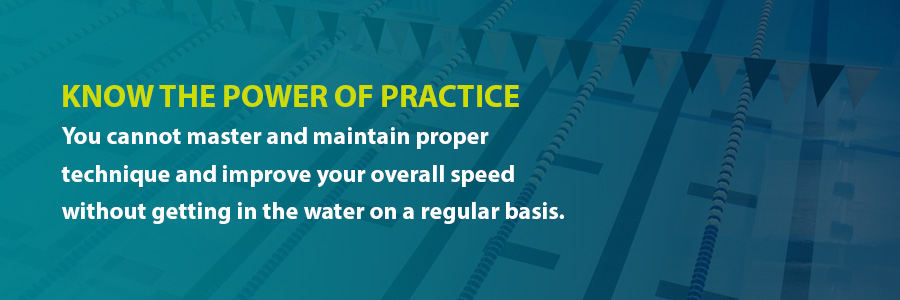
Set Goals
If you're focused on how to become a faster swimmer, you'll need to track your progress carefully. Set goals for yourself, and measure your improvement. Of course, everyone's goals will be different, but here are a few baseline goals to consider:
- 50-yard times: Swimming 50-yard drills is a great speed-training technique. Time yourself swimming this length. See if the time is within 95 seconds. If not, aim for that number. If you're swimming 50 yards in 95 seconds, aim for five seconds faster. Once you hit 90 seconds, see if you can do it faster. Once you've reached your peak time, work on maintaining that time for multiple sets.
- 100-yard times: When it comes to swimming 100 yards, you can aim for 160 seconds. Next, push yourself to complete 100 yards within 125 to 140 seconds. When you've reached your peak time, see how many sets you can finish at that time.
- Date your goals: When do you want to achieve your goals? Set a target date, and make a plan based on that date. Having something tangible to work toward is a powerful motivator.
- Break your goals into manageable steps: So you want to hit an incredible time. That's great, but how are you going to get there? Make your goal attainable by plotting out step by step the way you'll get there. Set a starting goal of getting into the pool a certain number of times per week. Set smaller goals for knocking time off your race bit by bit.
- Define your own success: Swimming is a competitive sport, but don't let that stop you from pursuing your own goals. While you practice, focus on what you're doing rather than what the person in the next lane is doing. When you reach a milestone or achieve a goal, remember to celebrate that success.
Invest in the Right Swimsuit and Gear
Proper technique, training and practice are the bulk of improving your swimming speed, but having the right equipment matters too. Here are three important pieces of gear that can help you achieve peak performance.
- Swimsuit: The right swimsuit fits your body like a second skin, which means you're positioned to have a minimal amount of drag in the water. Swimsuits for competitive swimmers are designed to be as hydrodynamic as possible. When it comes to swimming performance, many athletes swear by tech suits. Finding something comfortable with the right fit for you is the key to finding the right swimsuit, whether that's a tech suit or not.
- Goggles: The right pair of goggles keeps your eyes clear so that you can keep your head in the right position and focus on the rest of your technique. Try a few different shapes and sizes to find the pair that fits your eye sockets and feels comfortable.
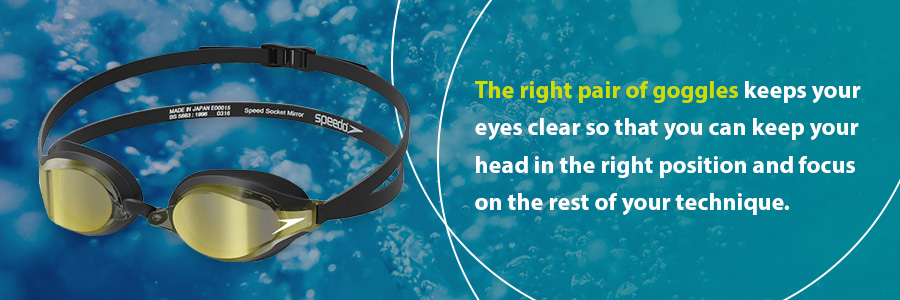
- Swim cap: If you have long hair, it will cause a little more drag in the water. If you want to feel even more hydrodynamic (without shaving your head), a swim cap will be a good investment.
If you're trying to reach peak performance, you'll need the right swimsuit and other gear from a supplier you can trust. At Kiefer, you can find just the right swimsuit, goggles, swim cap and other equipment to improve your swimming speed in no time. Every little bit counts in the water. Browse our selection of swimwear and tech suits to find the right suit for your workouts. When you're armed with the right gear and determination, your personal best time is just around the corner.
How to Improve Ankle Flexibility in Swimmers
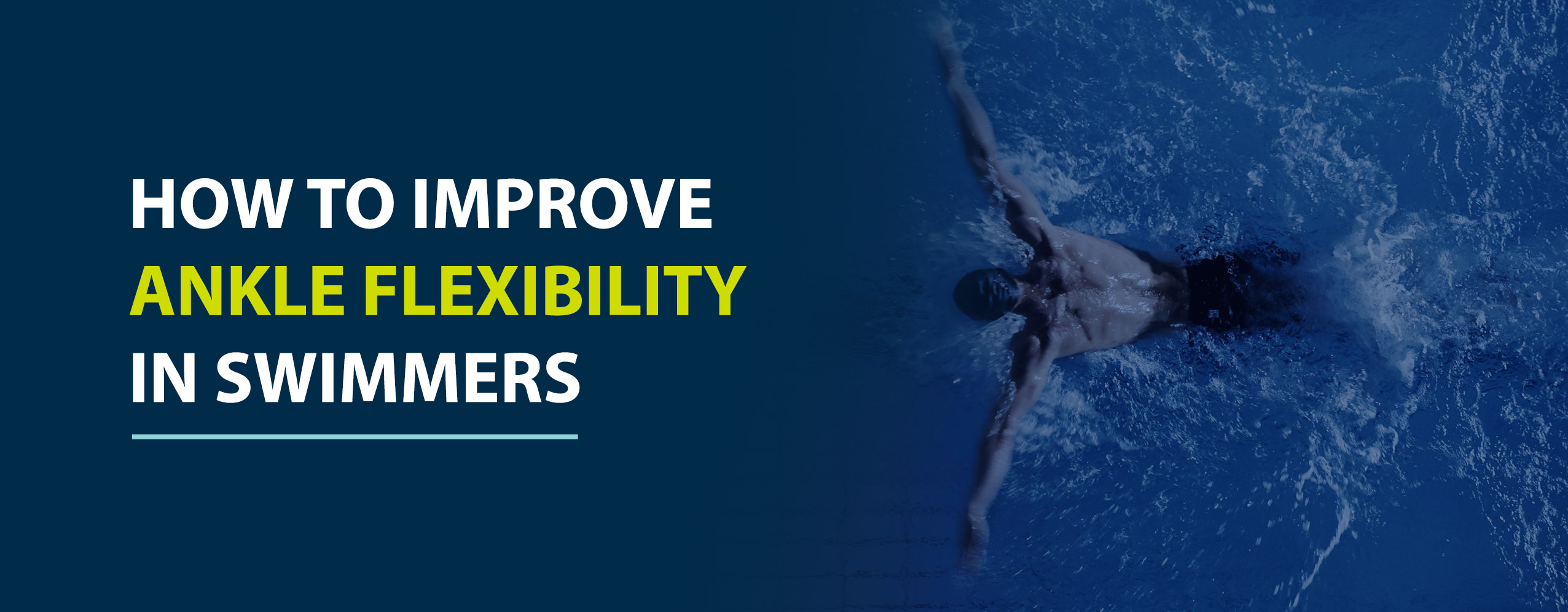
How to Improve Ankle Flexibility in Swimmers
Swimming requires a lot of strength training and stretching of the body to build strong, limber muscles. However, many swimmers forget that in addition to strong shoulders and legs, successful swimming also relies heavily on the amount of flexibility and mobility your ankles have. If you have stiff ankles, it can greatly hinder your ability to perform at your absolute best. Learn why ankle flexibility is so important to swimming success as well as different ways to increase ankle flexibility with these helpful tips and tricks.
Important of Ankle Flexibility for Swimming
Consider for a moment the amount of work your ankles take on when you are trying to propel yourself forward while swimming. The stronger your kick, the faster you can go. This is because the more flexibility your ankle has, the more water you can push behind you. This makes a huge difference in propulsion compared to kicking water downwards, which creates drag, slowing a swimmer down.
When you have flexible ankles, you have the ability to kick stronger because you can direct a larger surface area of water onto the top of your foot. A strong kick provides many benefits while swimming, including better body positioning, creating lift from the down kick to keep you swimming at a higher level in the water, and the ability to maintain stronger strokes from start to finish. Other benefits of ankle flexibility include:
- Improved balance in the water
- Reduced strain and pain on the limbs
- Ligament and tendon protection around the ankles
A stiff ankle greatly limits your range of movement, even if your back and shoulders are in top condition. In fact, it has been proven that flexible ankles directly contribute to increased kicking speed.
Poor ankle mobility can cause issues way beyond the ability to be a fast swimmer. Major concerns linked to poor ankle mobility include limited range of motion, training imbalances, and injuries due to overuse. You also run the risk of obtaining ankle, leg, knee, and hip injuries, which can put a quick halt on athletic swimming.
Assessments can be done to determine the amount of flexibility of your ankles. This can help you gauge any improvements that you may need to make to help increase and maintain ankle flexibility for swimming.
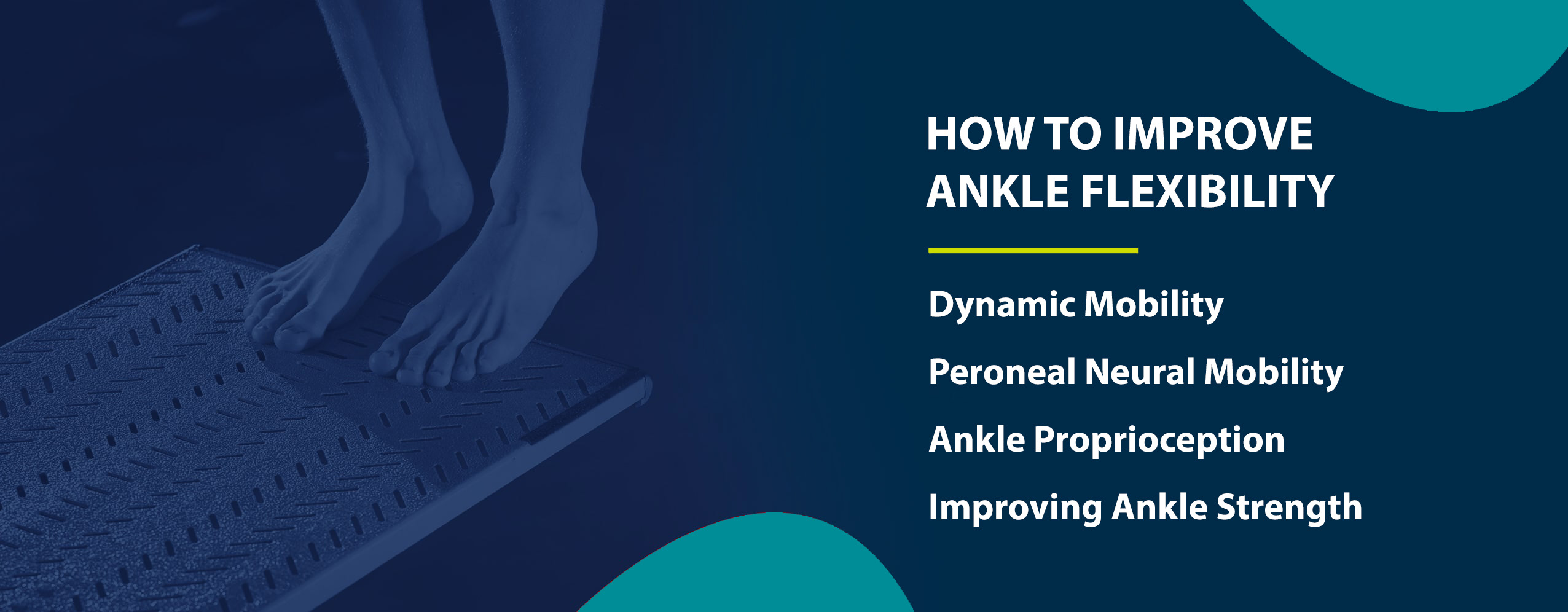
How to Improve Ankle Flexibility
Since it is so important for safe and successful swimming, it is a good idea to know various ways to increase ankle flexibility. Check out some of the best ankle stretches for swimmers to get started on improving the mobility of your ankles.
Dynamic Mobility
When it comes to stretching, a lot of people tend to forget about dynamic stretches. These stretches help with increasing ankle range of motion and can help to warm up the muscles to prevent injury. These can be done on your back, as well as through standing foot exercises such as a heel walk or toe walk.
Peroneal Neural Mobility
The fibular (peroneal) is a nerve that runs behind the fibula and into the front of your ankle. When it does not slide throughout its place as it should, mobility of the ankle is greatly reduced. To help with keeping this nerve in good condition, exercises such as fibular nerve flossing are a great solution. This can be done by sitting down. Point your toes, tilt your head back while sitting tall with your back straight, and then bring your head forward while pulling your toes up with an arched back.
Ankle Proprioception
Ankle proprioception is the ability of the ankle to sense its position in space. Swimmers that do not have adequate ankle proprioception often have difficulties with ankle range of motion. Balancing exercises are a great way to help improve ankle proprioception and increase ankle flexibility. Perform a balancing exercise by simply closing your eyes and rotating your head slowly from side to side while standing on one foot at a time.
Improving Ankle Strength
Strong ankles play a big part in allowing ankle flexibility. Specific exercises geared towards strengthening your ankles can greatly reduce drag while swimming and even help reduce the risk of injury. An elevated heel raise can not only help strengthen your calves but can also improve the range of motion within your ankles. To do this, place your foot on an elevated surface such as a step and raise yourself as high as you can, placing your weight only on the ball of your foot. Slowly bring yourself back down to help elongate and strengthen the muscles in and around your ankle.
Baby Feet Musculature
Tight plantar fascia and limited ankle mechanics greatly hinder a swimmer's ability to kick fast and strong. Improve these parts of your body through simple exercises to help increase movement and flexibility in your foot and ankle. All you need to do is roll a baseball under your foot, working the baby feet musculature that is commonly known to become tight and cramped while swimming. This will help to relax that area of your foot, allowing for a better range of motion.
Ankle Dorsiflexion
Baseballs and foam balls can be a great tool to improve the mobility of your ankles because they can be used to easily target trouble areas found in smaller muscle groups. Not only that but they can also help with improving blood flow and delivering more oxygen to hard-working muscles. Rolling a ball on the ankle dorsiflexion can be done by placing a ball on the ground and then gently rolling it with the lower part of the shin. This will help to relax the muscles and improve ankle flexibility.
Improve Toe Strength
Toes are often forgotten about but they play a major role in the ability to grab water and propel swimmers forward. That is why it is so important to strengthen your toes, and in turn, the rest of the muscles in your foot and ankle. Exercises can be done by gently flexing and spreading your toes apart from one another.
Improve Your Ankle Flexibility With the Perfect Dryland Training Equipment from Kiefer Aquatics
At Kiefer, we know how important it is for you to keep your body in the best shape for swimming at your best. That is why we are the superior swim shop for everything you need to strengthen your body for your next big swimming event. We pride ourselves in offering the best customer experience possible, with a customer satisfaction price guarantee, no-hassle returns, and free exchange shipping. Kiefer also offers unbeatable customer service to help you with any questions or concerns you may have.
Find what you need to improve your ankle flexibility today at Kiefer.
How to Burn More Calories While Swimming
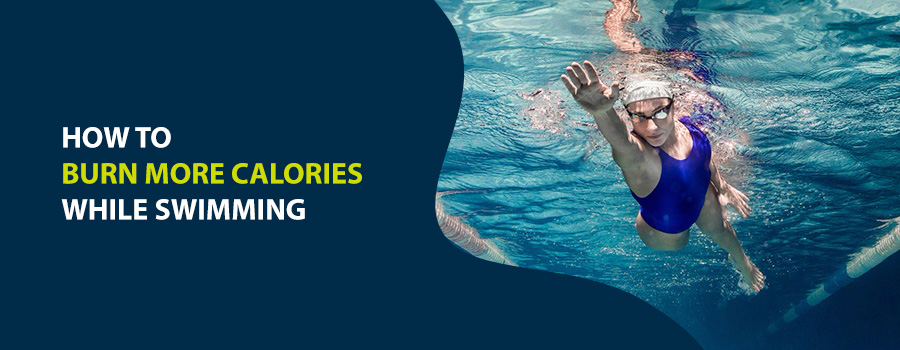
How to Burn More Calories While Swimming
Get the most out of your swim by using strokes and methods that burn the most calories. Increasing calorie burn improves your workout and can get you closer to your weight loss goals. Find out what factors determine how many calories you will burn and how to use that information to maximize the burn.
Factors that Affect How Many Calories You Burn While Swimming
In the water, not all workouts burn the same number of calories. For instance, the number of calories burned during an hour-long swim can range from 400 to 700. Other aspects of the workout will determine which of these values you are closer to burning, including the following:
- Duration: The longer you swim, the higher the total number of burned calories you can reach.
- Intensity: Hard and fast swimming burns more calories than slow, easy strokes.
- Efficiency: If you become too efficient at a stroke, you will reduce the number of calories burned.
- Stroke: Some swim strokes incorporate movement from more parts of the body or require you to work harder, and thus, burn more calories.
- Weight: Your body weight contributes to calorie burn. If you weigh more, you will burn more calories.
How to Burn Calories Swimming
When swimming as an exercise, you will likely burn a lot of calories. To get the most from your workout, increase the time and intensity while changing up your routine to avoid becoming too efficient in the water. Plus, you can choose the type of strokes that burn the most calories. If you want to increase the length of your swim sessions, do it in five-minute increments each week until you reach your goal time. Doing this gradual increase will help you avoid burnout.
What Kind of Swimming Burns the Most Calories?
All types of swimming burn calories. If weight loss is your goal, adopt a healthy diet paired with your exercise to ensure you don't take in excessive amounts of calories to make up for your workouts.
Depending on the water temperature, you may burn more calories by swimming in cold open water. Your body must generate extra heat to keep you warm, which burns calories. If the water feels so cold that you sacrifice using the correct form for your swim strokes, you won't get the same benefits. This is because you will be changing the effort required for the strokes and potentially reducing calorie-burning. To avoid this problem, wear a wetsuit when swimming in water with temperatures below 60 degrees Fahrenheit.
Swimming in a temperature-controlled pool is ideal for those who want to focus on their stroke form. Learning new strokes and working on more intense strokes can help you to burn more calories, even in a heated pool. As your body uses different muscle groups for the various strokes you use, you will get a better workout than using the same swimming stroke every session.
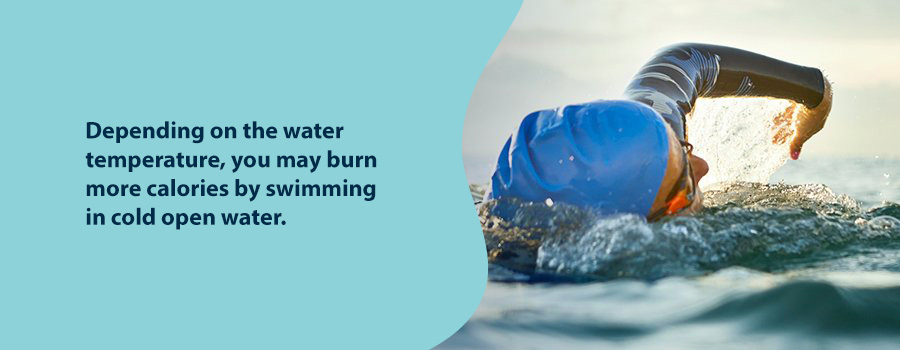
What Is the Best Swimming Stroke to Burn Calories?
When you want to improve your calorie burn, some strokes will offer a better workout than others. Other strokes are easier to sustain for a long time, allowing you to swim longer without wearing yourself out. We'll review each stroke and the benefits it can offer:
- Breaststroke: One of the lowest calorie-burning strokes is the breaststroke, which averages a burn rate of 200 calories per half hour. However, you can swim longer and build your cardiovascular strength and stamina with this stroke. It also works your chest, upper back, legs and triceps.
- Backstroke: The backstroke burns slightly more calories than the breaststroke with an average of 250 calories per 30-minute workout. Choose this stroke as another option for boosting your stamina. It can also help improve posture and the flexibility of your hips, which both may need attention if you have a sedentary job.
- Freestyle: While you may choose a freestyle stroke for racing because it's the fastest option, it only ranks second in calorie burning. On average, you will burn around 300 calories when you do this stroke for half an hour. It does a great job of giving you a workout to tone all your major muscle groups in the back.
- Butterfly: The most intense calorie-burning stroke in the pool is the butterfly stroke. This powerhouse stroke burns up to 450 calories per 30 minutes, but it may be the most difficult to learn. In return, you get a great exercise that strengthens and works most of the major muscle groups in your body, which may explain its high calorie-burning value.
Benefits of Swimming to Burn Calories
Swimming provides a whole-body workout that is less stressful on the joints compared to high-impact aerobics. Consequently, many people in recovery from injuries from more intense sports use swimming as a way to rebuild their stamina, muscle tone and aerobic capabilities while improving the recovery process.
Competitive swimmers already know their sport facilitates massive calorie burn, which is ideal for those whose goal is weight loss. Plus, swimming can help those with asthma or multiple sclerosis to exercise without worsening their conditions.
While swimming works your entire body, it can also help you to maintain your mental health. Those who get regular aerobic exercise, like swimming, have better sleep quality than those who don't. In a study of dementia patients, participation in aquatic exercise improved mood and psychological well-being.
Statistically, swimmers have a 50% lower chance of death compared to their inactive peers. The calorie-burning, mood-boosting, sleep-helping and muscle-building benefits of this exercise likely play roles in this connection. Whether you want to build your stamina, lose weight or maximize your calorie burn, competitive swimming gives you a way to do that. Rather than relying only on yourself to schedule workouts, your team will rely on you to attend practices and improve your skills. Plus, with a team, you have others relying on your ability in the pool. You cannot miss a workout, or you will let them down.
Competitive swimming also gives you a goal to work toward. If you achieve your initial aim, you can continue to compete at higher levels as your skills improve.
Give Yourself an Edge in the Water With Our Swim Products
Give yourself an edge in the water with men's swimsuits, women's swimsuits, goggles and more for competitive swimmers at Kiefer. Plus, we offer gear for facilities, water fitness and training. Whether you need to shop for your team or yourself, make your first stop Kiefer for the products you need from brands you trust.
10 Benefits of Swimming Competitively
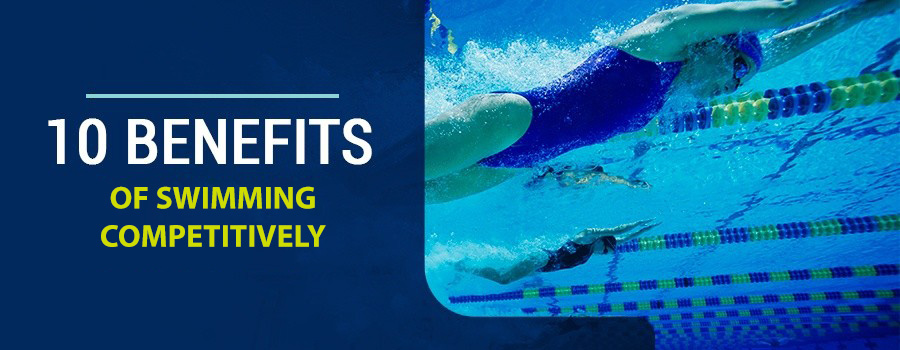
Competitive swimming is more than a fun sport or a simple way to cool down in the summer. It also offers significant physical, mental and social benefits for both adults and youth. Swimming requires intense focus and discipline, all while exercising nearly every part of your body, including your muscles and cardiovascular system. The skills you acquire during competitive swim training are also highly applicable to other areas of your life, including work, school and relationships.
Here are 10 reasons you should consider joining a competitive swim program.
1. It Can Relieve Stress
With workloads, school assignments and personal obligations, juggling all your responsibilities can get overwhelming. Swimming is a great outlet to release this stress. Swimming is a type of aerobic exercise that creates a sense of calm and reduces your body's natural adrenaline and cortisol levels. At the same time, it produces endorphins, which are natural mood boosters. All these chemical reactions mean swimming will not only help relieve stress, but you might also finish your competitive training session feeling better than ever.
2. You'll Meet New People
One study from the University of Minnesota found young adults who implement regular socialization and exercise into their routines tend to have better mental health than those who don't. With competitive swimming, you have the opportunity to do both! Whether you're new in town or seeking opportunities to meet people, joining a competitive swim team opens doors to making new friends. You'll get the chance to bond with your teammates and competitors over a shared interest and common goal, and have fun while you're doing it.
3. It's Good for Your Cardiovascular Health
You likely already know that exercise is an essential part of maintaining your cardiovascular health, but swimming is one of the best forms of exercise you can do for your heart. As you propel yourself in the water, the force of the water pushes back. The act of moving through this resistance offers a vigorous workout that's gentle on joints, minimizing the risk of common exercise-related injuries. Water buoyancy also takes stress off vulnerable spots, making it easier to exercise for extended periods.
4. It Teaches Valuable Water Skills
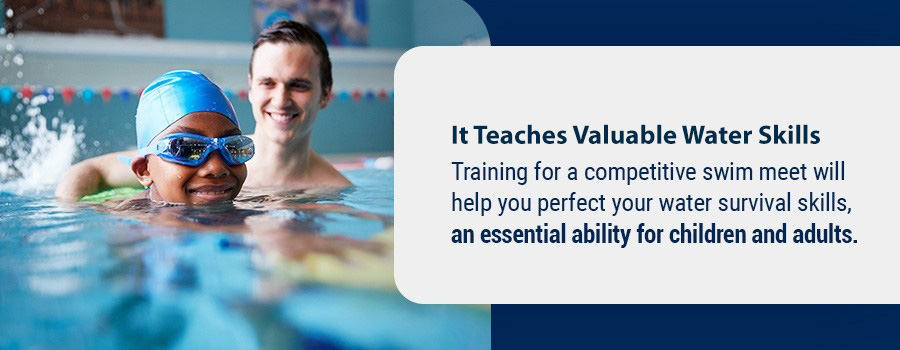
Training for a competitive swim meet will help you perfect your water survival skills, an essential ability for children and adults. The better swimmer you are, the safer you are in non-competitive settings, like when at the beach or on a boat. Learning how to swim well is especially crucial for young kids, who are at a higher risk for accidental drownings. By joining a competitive swim team, you can work one-on-one with coaches and teammates to learn and perfect these skills.
5. It Will Build and Strengthen Muscles
One of the most significant health benefits of swimming is the ability to target muscle development in critical areas of your body. The same water resistance that improves cardiovascular health can also help you build and strengthen muscles in your arms, legs, core and other places for a stronger, leaner body. Building muscle strength also reduces your risk of injury, increases your mobility and flexibility and even reduces the likelihood of developing some diseases.
6. It Can Help You Achieve Weight-Loss Goals
Are you looking for a program to help you manage your weight? Swimming is a great option — especially in a competitive setting where you and your fellow competitors can keep each other accountable for your training progress. Weight loss through a sport is also an excellent way to work toward your goals without letting them become your sole focus. Instead of zeroing in on your weight alone, you're also trying to beat your previous lap time or perfect a specific movement. Swimming will help you establish more realistic, sustainable weight-loss habits that you enjoy doing.
7. It Fosters a Healthy Sense of Competition
With competitive swimming, there is always something to conquer, whether it's your opponent, your fitness goals or setting a new record. The act of setting and achieving these goals — whether personal or against an opponent — hones your ability to focus and push yourself. Plus, every time you win or exceed the goals you've set, you're boosting your self-esteem and letting yourself know that you can overcome challenges.
8. It Lets You Practice Self-Discipline
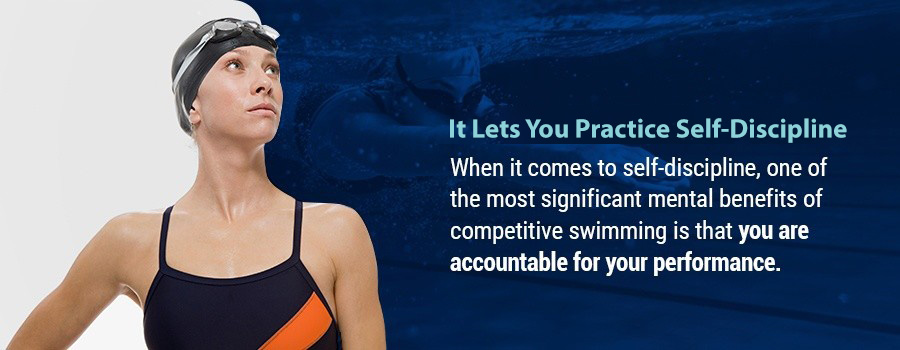
Swimming competitively is different from swimming recreationally. Because you're working to meet specific objectives, you must develop a robust sense of self-discipline to train and practice. You'll need the willpower to create a schedule that integrates your new commitment and then stick to it, which also perfects your time-management skills.
When it comes to self-discipline, one of the most significant mental benefits of competitive swimming is that you are accountable for your performance. After every practice session and swim meet, it's up to you to analyze your performance and identify what you did well and areas you would like to improve on before your next event.
9. It Keeps Your Mind Sharp
If you want to keep your mind sharp, physical exercise and continuous learning are two of the best ways to do it — and competitive swimming provides both.
- Physical exercise: Physical exercise stimulates your brain, promotes better coordination and puts you closer in touch with cues such as when to go faster and how to manage your breathing. The more you move — especially when participating in a new, rigorous exercise program — the more abilities you can master.
- Continuous learning: Even if you're a seasoned swimmer, you'll soon find yourself learning new skills and strengthening existing ones when you join a competitive swim program. This continuous learning nourishes your brain. According to the Alzheimer's Association, lifelong learning can even help reduce your risk of cognitive decline.
10. You'll Learn Transferable Skills
One of the most significant reasons you should start competitive swimming is that these mental, social and physical benefits of swimming apply to other areas of your life.
- Mental: The self-discipline, time-management and goal-tracking you learn through competitive swimming can benefit all other areas of your life, like school or your profession.
- Social: The more practice you have navigating different social settings, the easier it will be to engage with new people. Competitive swimming will help you learn the art of compromise and sportsmanship, an asset in everyday life.
- Physical: Regular exercise will help you stay positive and feel healthier while strengthening the muscles you need to tackle other areas of your health and fitness goals. Competitive swimming promotes a healthier lifestyle, which lessens your chance for diseases and keeps your mind and body strong.
Get Your Competitive Gear at Kiefer
Competitive swimming is fun and can help you achieve a happier, healthier and more social lifestyle. If you're ready to dive into competitive swimming, Kiefer has the competition swimwear and training gear you need to succeed. Kiefer, we carry an extensive inventory of products from the top brands in the industry, so you can always find what you need to achieve your swimming goals. Visit our blog to learn more about competitive swimming and pick up some new gear today!
Improving Breaststroke During Off Season

Improving Breaststroke During Off Season
If you’re already missing being outside and the rush of drills, it may be time to start doing off-season lifeguard training! Just because you’re not working doesn’t mean you can’t improve your skills. If you want to work on drills and skill development, the breaststroke swimming technique is something you may not often think about. Though it's a widely used athletic and leisure swimming stroke, lifeguards don’t use it as much because of its slow speed. However, the breaststroke is essential for improving your swimming abilities and staying in shape during the off-season. If you're looking to improve your breaststroke in the off-season, Perform the drills outlined here to get ready for your best season yet.
What Is the Breaststroke Swimming Technique?
For many years, the breaststroke has been one of the most popular and widely used swimming strokes. It's excellent for beginners and experienced swimmers alike because it allows you to breathe freely and keep your eyes open without needing goggles. So, how do you typically execute a breaststroke?
- Start by floating in the water with your legs together and your arms straight out in line with your head. Your head should be looking straight down.
- To propel forward, move your arms out to the sides through the water, staying fully extended the whole time, until your elbows are in line with your shoulders. Then, swiftly move your hands toward each other until your palms touch. Continue moving forward until you have fully extended your arms to the front again.
- While your arms are moving backward, your body should naturally transition from a 90-degree angle to a 45-degree angle in the water. Your shoulders and torso will be mostly out of the water, with your hips and legs still submerged. When your palms meet and your arms extend forward, the rest of your body should follow until it again makes a straight line from toe to fingertip on top of the water.
- While moving your arms backward, your legs should generally stay in the same position. Once your elbows are almost in line with your shoulders, bend your knees and move your feet closer to your butt. When your arms are moving forward, move your knees apart while separating your legs outward and backward, resulting in a propelling kick. Then, move your legs inward until they are together and extended again in the beginning position.

Tips and Drills to Improve Breaststroke
Once you have perfected the breaststroke swimming technique basics, you should learn how to improve your breaststroke in the off-season. Doing so is especially critical for lifeguards who only work in warmer weather. Staying in shape and practicing in the off-season is essential to keep your skills honed and ensure you can still perform safety and rescue skills. The advantage of practicing your breaststroke is that it will help keep you in shape and improve your muscle function for swimming without wearing you out. Go to your local YMCA or pool at least once a week and work on these drills to hone your breaststroke technique.
- Timing: Timing is a critical skill to practice for improving your breaststroke. Either your arms or your legs should be propelling during this stroke. However, they shouldn’t be doing so at the same time. Simultaneously working both will result in unnecessary fatigue. Practice your breaststroke while counting to make sure you are moving your legs while resting your arms and vice versa.
- Don’t look down: An easy tip to improve breaststroke performance is to properly focus your eyes. It’s a common misconception that you should be looking straight down toward the bottom of the pool during the breaststroke. Instead, to improve focus and performance, look three to six feet ahead.
- Foot position: Do you point or flex your feet during the breaststroke swimming technique? Trick question — the answer is both. Improve your breaststroke in the off-season by paying attention to your feet. When your legs are propelling backward, flex your feet for maximum pull. However, once your legs come back together in the flat position, point your toes to glide smoothly and fluidly through the water.
- Breathing: As with any stroke, improving breaststroke in off-seasons also depends on breathing techniques. Perform a breathing exercise to improve your breaststroke in the water. Submerge your face as you would during the stroke and hold your breath for one or two seconds longer than usual. Then, bring your face out of the water and take a deep breath before submerging again. Repeat this breaststroke drill at least 10 times per swimming session. It will help you with this stroke while improving your overall breathing skills for swimming.
- Kicking: To develop a more powerful breaststroke kick, you can perform kick drills. Hold on to the edge of the pool with your hands. With your legs, kick as if you were swimming through the water doing the breaststroke. Focus on what your legs are doing — your knees should be hip-width apart and slightly below your hip line when kicking. Repeat this drill each time you go to the pool to strengthen your legs and make your kicking more fluid.
As with any other stroke, your ability to maintain buoyancy, arm strength and leg strength is critical to improving breaststroke in off-season training. Doing weight-retrieving drills, strength training and working on other strokes are also crucial to developing your backstroke and overall lifeguarding skills. 
Get the Right Swim Gear for Training
Need some training gear for the off-season? Get in shape with top-quality gear and apparel from The Lifeguard Store. From resistance gear to diving rings and bricks to speed apparel that will help you glide through the water, Kiefer has everything you need to improve your breaststroke during off-season training and prepare for the upcoming season. Get in your drills to improve breaststroke technique and your other skills during the off-season and depend on Kiefer to supply anything you need.
Introducing Kiefer’s 2016 Spring/Summer Look Book
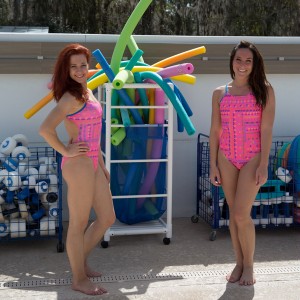 At Kiefer we are passionate about swimwear! For Spring/Summer 2016 we have created our first ever Swimwear Look Book, introducing the newest additions to our Kiefer Swimwear line: Kiefer Khaos, Kiefer Team prints, Kiefer Techno splice and updates to Kiefer Krazies. We showcase our latest swimwear print patterns and suit designs created exclusively by the Kiefer Design Team.
At Kiefer we are passionate about swimwear! For Spring/Summer 2016 we have created our first ever Swimwear Look Book, introducing the newest additions to our Kiefer Swimwear line: Kiefer Khaos, Kiefer Team prints, Kiefer Techno splice and updates to Kiefer Krazies. We showcase our latest swimwear print patterns and suit designs created exclusively by the Kiefer Design Team.
The Kiefer team works a year ahead researching the newest and latest fabrics, color pallets and latest trends. Our team gathers information from multiple sources to insure we offer trend right product to our customers. Kiefer swimwear is designed for competitive swimmers who are dedicated, train hard, motivated and have the desire to win.
Krazies Collection pattern inspiration
The color blue is a foundation color to our Kiefer brand. Natural blues inspired by water patterns with ripple effects and sunlight reflecting on pool water. Blues range from classic ultra-marine to royal blue in our newest pattern. | Kaleidoscope 700510 (Coming June 2016!)
Core graphical pattern repeats, inspired by circular shapes, bubbles and water sprays. Black background color with highlighted by pops of red and gray accents. | Bubbles Up 700509 (Coming June 2016!)
Offbeat interpretation of leopard skin print mixed with a vibrant color block background. Shades of pink and fuchsia are accented by vibrant orange and purple contrast. | Leo Splice 700511 (Coming June 2016!)
Kiefer Khaos Collection pattern inspiration
Kitschy and fun neon color prints. Inspired from detailed, far off places where buildings are adorned in vivid color, decorated lines and patterns. | Neon Kitsch 700702
Futuristic fashion and space travels, highlighted with fragmented shapes accented by bold strokes, and linear lines creates an edgy neon bright look. | Neon Tristroke 700703
Kiefer Team Volcanic Eruption pattern inspiration
Fluid lines, freedom in movement are reminiscent of hot lava and molten forms. Volcanic Eruption is offered in our top 3 most popular team color Navy/Gold, Green and Red. | Volcanic Eruption 700140 & 700145
Kiefer Team Techno Splice style inspiration
Inspired by sleek shapes, architecture and engineered waves. Splices of color overlap and weave together to create sculptured looks for our. | Techno Splice 760300 & 760350


